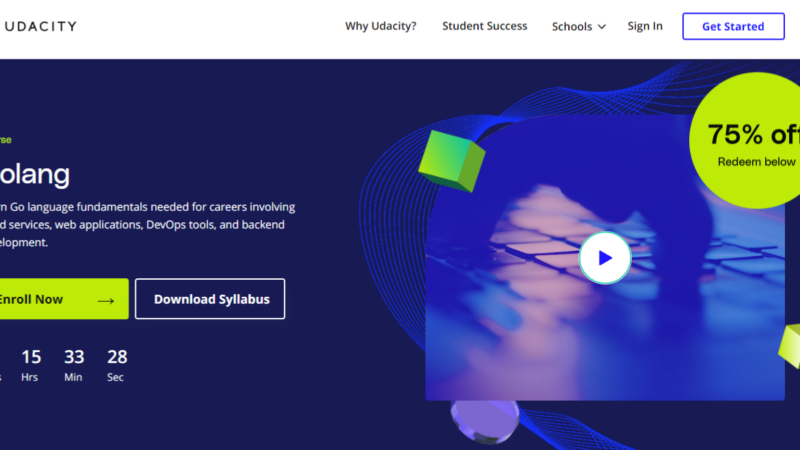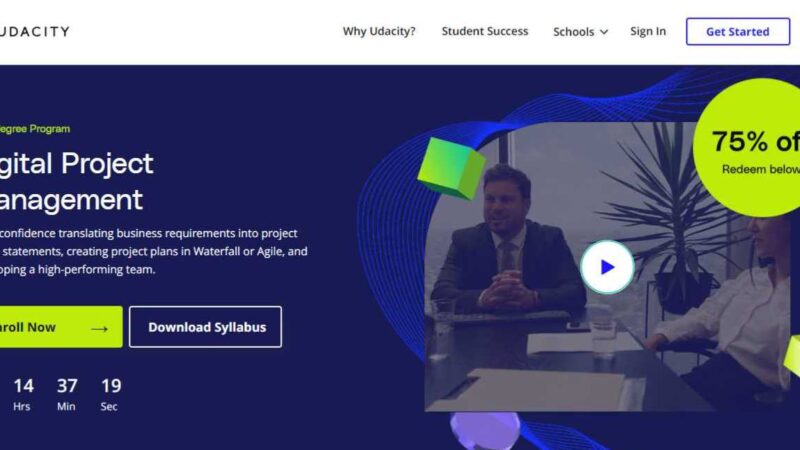Udacity Flying Car Nanodegree Review

Udacity Flying Car and Autonomous Flight Engineer Nanodegree Review
How would you like to be on a team of super-sophisticated developers that know how to work with advanced technology and code to power flying cars? Think it sounds too good to be true? Well, we are here to tell you it’s not! Make all of your sci-fi dreams come true with the skills to write code that powers self-driving machines.
How, you ask? You can score the skills with Udacity’s Flying Car and Autonomous Flight Engineer Nanodegree. It has a full curriculum from start to finish plus, projects mixed in that help you test and enhance your skills. The world needs cool new inventions, and you could be the one creating them in less time than you think.
About Udacity
Udacity is an online academy that specializes in everything IT. They were founded by two University of Stanford professors, with the goal of bringing advanced concepts to learners all across the globe. They have free courses and lessons that range from beginner to advanced, all video-based. One of their star courses in the Udacity Nanodegree, and we have more of the scoop on that below.
What’s a Nanodegree?
A Nanodegree from Udacity is a short certification course that is targeted toward those who want to start a career in IT. Most of the content is created in collaboration with top IT companies in the industry, complete with curriculum and real-industry examples to go along with the content. Included with each Udacity Nanodegree is:
- Self-paced online learning
- Projects that mimic industry issues
- A technical mentor
- Access to a learner’s community
- Career prep featuring mock interviews
- Lessons led by A-list instructors
Meet your Instructors
Udacity goes for the top professionals in the industry when it comes to finding instructors. You will have the honor of learning from experts with amazing educational backgrounds and impressive industry experience with some of the top names in IT. For the Flying Car and Autonomous Flight Engineer Nanodegree, your instructors are:
Nicholas Roy
Nicholas is part of the team of Computer Science and Artificial Intelligence at MIT. For years, he has been a professor of Aeronautics and Astronautics, preparing a ton of university learners for the field. On top of that, he is the founder of Project Wing with X. He is intelligent and has years of teaching experience on top of experience working with the top technologies in the field.
Angela Schoellig
Angela is employed by the University of Toronto. There, she is an assistant professor in the Aerospace Studies department and the associate director of the center of Aerial Robotics Research and Education (CARRE). Her expertise in topics combined with her years of teaching makes her an effective instructor, one that you won’t want to miss.
Sebastian Thrun
Sebastian is the owner and founder of Udacity. His knowledge of IT expands far and wide, combining with his business and entrepreneurial skills that makes him a triple threat. On top of Udacity, he has founded Google X, where he is the top dog in charge of the Self-Driving Car projects and many other Google-driven technologies.
Raffaello D’Andrea
Raffaello is a professor at the Swiss Federal Institute of Technology (ETH). There, he specializes in Dynamic Systems, leading-learners through entire courses. Apart from his time teaching, he also works on creating his own projects, of which he has Verify Studios and Kiva Systems.
Sergei Lupashin
Sergei has dabbed in a bit of everything when it comes to advanced technology. He has worked with industrial drones, self-driving cars, and other advanced technologies. He took off work with lots of technology after his education, using that to help him with his personal projects as well. He is the founder of Fotokite and a TED fellow.
Jake Lussier
Jake is working on his Ph.D. in AI with Stanford University. His focus is on robotics, attempting to create machinery that mimics human movements. His experience goes into all the far-out spaces of deep learning and machine learning, where he has developed and helped design some pretty cool gadgets in his time.
Course Breakdown
In this course, you’ll work with Udacity’s flight simulator and other technologies to start getting the wheels in your brain turning about the possibilities that come with advanced technologies.
Prerequisites
This course is a bit on the advanced side and is not recommended for beginners or newcomers to the world of IT. This course is best for those with programming knowledge and a good base of mathematical skills taught in the Intro to Self-Driving Cars Nanodegree from Udacity. You should know:
- A bit of Python
- C++ up to an intermediate level
- Linear algebra
- Knowledge of statistical concepts and probability
- Physics- having at least a foundation of concepts
Into to Flying Cars
In the introduction of this course, you’ll learn about the platforms you’ll be using throughout. Meet Udacity’s simulator, taking it for a spin and seeing how it works to help you create technology advanced enough to fly!
Project One! Backyard Flyer
Start working with code immediately! Experiment with the simulator and make your drone fly or create a predetermined path. The goal after you get comfortable is to make the drone land in a backyard using only code, good luck!
3D Motion Planning
Now it’s time to take your skills up a notch, going from a 2D environment to 3D. In doing this, you can lead your drone through a ton of different environments and work more on creating a safe flying zone.
Project Two! 3D Motion Planning
This project was built to help you practice the skills that you just learned. Instead of flying to the backyard, you’ll navigate your way around a city! Using a downloaded map, you will write code that will allow your drone to fly high above the city streets and to any destination you are wanting it to.
Controls
Of course, when controlling any kind of machinery, you’ll need different methods to do so. This part of the course is all about creating a controller for your drone. Get it up in the air and flying safely with you behind the wheel determining its every move.
Project Three! Build a Controller
Here is where C++ comes in. You’ll use the advanced programming language to create controllers that help your drone go from fast to slow and vise versa. Plus, you can record its every move and monitor performance to enhance your code.
Estimation
In this lesson, you’ll design an Extended Kalman Filter (EKF), which is used to estimate altitude and position. You’ll use techniques like sensor fusion and filtering to help you get the best results and the most out of your advanced flying machine.
Project Four! Estimation
Using the data collected from a flying robot, you’ll create an EKF to create a full-stack flying robot. Look at things like altitude and position plus, GPS, or route for flying.
[Optional] Fixed-Wing Aircraft
This part of course is optional but, you should definitely give it a try. It introduces you to fixed-wing flight, allowing you to apply what you learned throughout the course. It ends with a project where you will write code for a fixed-wing aircraft, trying to see if you can make it more efficient.
How Long Does the Course Take?
Udacity estimates that the course will take about 4 months to complete. They base this estimate on dedicating 15 hours per week to the course. This is highly variable depending on the type of student you are and how fast you pick up on the material. You have a chance to learn at your own pace, only keeping up with the project deadlines. Before you jump for joy and take off to sign up though, you might want to listen up to this little bit of information, as time does cost you money.
How Much Does the Course Cost?
The course cost is an important deciding factor. Udacity attempts to give learners of all budgets a chance to take the course. To try and complete this goal, they offer two ways to pay, each coming with their charm. The ways to pay are:
Pay Per Month
To pay as you go, you can finish faster than Udacity’s estimate. However, you can also take more time, something that will drive up the cost. With this option, you’ll pay €359 for each month that you have access to the course. All of the Udacity perks are included as long as you pay, and you can keep on as long as you like-as long as you keep up with the deadlines.
Udacity’s Deal
Going this way, you only pay a one-time fee. This comes with 4 months of access plus, a 15% discount for paying upfront which comesout to €1236. This is a great option if you have some money set aside, using it to get the course paid and done. Taking this option, you can take your time and really absorb the information, making sure you understand thoroughly before moving on to the job market.
What Have Learners Said?
The course is highly rated on the web, with a 4.6 out of 5-star rating. Don’t take it from us though, here is what a few learners had to say about their experience with the Flying Car and Autonomous Flight Engineer Nanodegree.
“I was skeptical before starting about what the quality of this online course would be like given my experiences on other platforms and so far I’ve been blown away by the structure and content. It can be very difficult to find material on an advanced subject so I am delighted that Udacity exists to fill that void!” – James M.
“It’s hard and above my level of comfort but I am trying But at the same time it is top stuff, totally practical. It is making me go back to school and university days and try to remember math and programming stuff. If I survive I am going to have new circuit opened in my brain.” – Andrija E.
“While I didn’t know what to expect from this program being targeted to such an out-of-this-world concept (flying cars). It very nicely integrated the concepts of flying cares into drones – an everyday vehicle that anyone can gain access to. The content was first class, teaching some extremely advanced concepts that are only taught at the best universities in an easily comprehendible manner. Each lesson is broken down well into it’s roots to build on top of. Overall another fine course by Udacity!!” – Chris K.
What’s the Job Market Like?
According to Paysa, a flying-car engineer rakes in about $238,000 per year. Amazing right! Of course, this is an average and, as a rookie, you do have to climb some of the ranks. However, a job in this field is easier to come by than you might think. Why you may ask? Well, that is because individuals that have the skills needed to land a job in the field are few and far between.
The demand for the job is high, with a lot of empty seats to fill from some of the top companies out there. What does that mean for you exactly? Well, that means that you are very likely to find a job. Even right after graduation!
Become a Flying-Car Engineer
If you’re looking for an exciting career that works with advanced technologies and powers robotic gadgets, Udacity’s Flying Car and Autonomous Flight Engineer Nanodegree is the way to go. You’ll not only get the curriculum but also hands-on experience that you can use from your first day and beyond. Udacity has:
- Great reviews from their previous learners
- Hands-on projects that mimic real-industry issues
- A few ways to pay to suit any budget
- Amazing perks that learners can benefit from
That being said, you really don’t have a reason not to take the course, right? We didn’t think so. Do your future self a favor and sign up today, you from today will be so happy you did!





